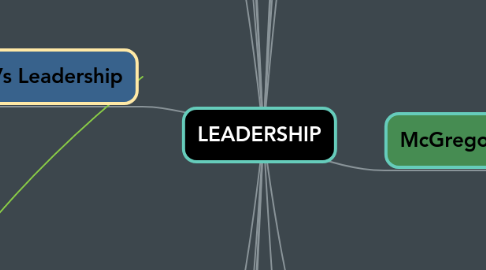LEADERSHIP
Door Sacha Pollard


1. Traits focused
1.1. Authentic
1.2. Charismatic
2. Servant Leadership
2.1. Followership
3. Blake and Moulton's Leadership Grid (1964)
3.1. Team Management
3.2. Authority - Compliance
3.3. Country Club
3.4. Impoverished
3.5. Middle-Of-The-Road
4. Leadership Development
4.1. Needs analysis
4.2. Evaluation
4.3. Can you Develop a Leader?
5. Management Vs Leadership
5.1. Transactional Leadership
5.1.1. Clarifies
5.1.2. Facilitates
5.1.3. Specifies Benefits
5.2. Transformational Leadership
5.2.1. Generates Awareness
5.2.2. Broadens Interest
5.2.3. Stimulates Followers
5.3. Laissez Faire
5.3.1. Indecisive
5.3.2. Uninvolved
5.3.3. Poor Crisis Management
6. Hersey & Blanchard's Situational Leadership (1969)
6.1. Directive Behaviour (Task) and Supportive Behaviour (Relationship)
6.1.1. S1-Directing
6.1.2. S2-Coaching
6.1.3. S3-Supporting
6.1.4. S4-Delegating
7. Challenges
7.1. Leadership as an Attribution
7.2. Substitutes & Neutralisers
7.3. Finding & Creating Leaders
7.4. Trust
7.4.1. Deterrence Based Trust
7.4.2. Knowledge Based Trust
7.4.3. Identification Based
8. What is Leadership?
9. HRM
9.1. Managers
9.2. Employees
10. Welcomes leaders to self reflect
11. Behavioural focused
11.1. Transactional v Transformational
11.2. Directive v Participative
12. Ethical Leadership
12.1. Misbehaviour
12.2. Morale
12.3. Power abuse
13. Authentic Leadership Luthans & Avolio (2003)
13.1. Self-awareness
13.2. Internalized moral perspective
13.3. Balanced processing
13.4. Relational transparency
14. Unique to the leader, drawing on personal experience.
14.1. Moral reasoning
14.2. Consideration for critical life events
14.3. Promotes relationship building between leaders and employees.
15. McGregors X & Y Theory (1960)
15.1. Theory X
15.1.1. Authoritarian
15.1.2. Hands On
15.1.3. Pessimistic View
15.2. Theory Y
15.2.1. Participative
15.2.2. Ownership
15.2.3. Optimistic View
16. Distributed Leadership
16.1. Conceptual Approach
16.2. Analytical Approach
16.3. Shared & Collective Leadership
17. Leadership Styles
17.1. Autocratic
17.1.1. Command & Control Approach
17.2. Authoritative
17.2.1. Visionary
17.2.2. Follow Me Approach
17.3. Pace-Setting
17.3.1. Results Driven
17.3.2. Do As I Do
17.4. Democratic
17.4.1. Participative
17.4.2. Autonomy
17.5. Coaching
17.5.1. Unblocks Potential
17.6. Affiliative
17.6.1. Supports Emotional Needs
17.6.2. Collaborative

